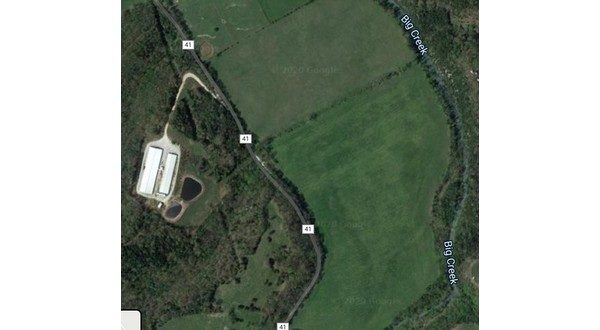
Photo: Arkansas hired a contractor to clean up two lagoons at C&H Hog Farms that could hold up to 2 million gallons of liquid hog feces and urine. Photo: Google Maps
While the controversial C&H Hog Farms Inc. in Newton County is closed now, waste lagoons are in the process of being drained and contaminated soil scraped way, according to Arkansas officials and a report from the Springfield News-Leader.
The work is being conducted under the terms of a $749,000 cleanup contract.
The two waste lagoons containing hog feces and urine were 90% full when the work began on Jan. 15. The lagoons could hold up to 2 million gallons of liquid waste, which environmental groups fear could leach into groundwater or reach the Buffalo National River 6 miles away if they ever overflowed.
Last year, Arkansas officials yielded to public pressure and agreed to use a combination of public and private funds to buy the hog farm from its owners for $6.2 million.
The nonprofit Nature Conservancy contributed up to $1 million of that amount to help close the hog operation, which at its peak could house more than 6,000 hogs inside two large, confined feeding buildings.
Under terms of the agreement, the hog farm owner gets to keep the land and buildings, but can’t use them for any confined animal feeding operations. Instead, the Arkansas Natural Heritage Commission, a part of the Division of Arkansas Heritage, will hold a conservation easement on the property, which is adjacent to Big Creek and about 6 miles from the Buffalo River.
The $749,000 cleanup contract is not included in the $6.2 million farm acquisition cost, according to the Arkansas Department of Environmental Quality.
David Peterson, president of the Ozark Society, a nonprofit group that successfully fought the Buffalo River from being dammed decades ago, says he is glad the hog farm is closed.
But he doesn’t think ADEQ is doing enough to clean up the site or follow-up with groundwater testing to ensure hog-waste pollution won’t affect nearby Big Creek or the Buffalo River.
“The sludge that’s in the bottom of the ponds, they say they’ll remove six inches of it,” Peterson says. “We think it should be 12 inches. If they can do 6 inches they can easily do 12. We also asked if there will be any testing of the clay liner to see what (pollutants) are really in there. Typically, there is a plume of nitrate and phosphorus below those kinds of ponds. We asked for them to investigate the existence of such a plume, but there’s no indication they’ll do that testing.”
Asked if there will be any ongoing monitoring of groundwater or creek water on or near the property once the cleanup is over, ADEQ said the closure agreement does not include that.
“The agreement between the farm and the state does not address ongoing monitoring of groundwater or surface water,” ADEQ says. “Several monitoring stations on Big Creek and the Buffalo River already exist, and we expect the entities that conduct monitoring there will continue to do so.”
Peterson says more needs to be done to ensure the hog farm doesn’t contribute to algae blooms on the Buffalo River.
Responding to a News-Leader inquiry, ADEQ detailed how the cleanup will occur.
First, the contractor, Denali Water Solutions, LLC, will pump out the waste lagoons and transport the liquid to a third-party treatment facility outside of the Buffalo River watershed.
“Once the waste is removed from the lagoons, a minimum of six inches of the soil will be removed from the bottom and inside levees of the pond,” ADEQ says in an email.
“After the 6 inches of soil is removed, the earthen waste storage ponds are to be demolished by filling and grading the site with a uniform or terraced slope from beyond the west of the pond on the high side to beyond the toe of the slope of the pond on the east. This will prevent any accumulation of water. Upon completion of the earthwork, all disturbed areas are to be filled, graded, and vegetated.”
When it was operating, C&H sprayed liquid hog waste as fertilizer on nearby fields. ADEQ says the cleanup agreement only involved the waste storage ponds.
“The fields that the owners of C&H Hog Farm used to land-apply the waste while it was operating are not part of the closure process as outlined in the legal agreement between the farm and the State,” ADEQ says.
ADEQ says the waste lagoon cleanup is scheduled to take 90 days, but it could be longer under adverse weather conditions. The cleanup cost also could increase, if heavy rains during the cleanup period require the contractor to haul away more contaminated material than expected.
Asked if there any evidence the adjacent creek, or the Buffalo National River suffered algae blooms related to hog waste getting into the waterways, ADEQ focused on what the closure agreement entailed.
“The agreement between the State and C&H directs ADEQ to close the waste storage ponds,” ADEQ says “Algal blooms of varying size have occurred for a number of years on the Buffalo National River and its tributaries. The size and variance of location of blooms over the years would suggest that there are multiple sources of nutrient loading in the Buffalo River watershed.”
ADEQ has a temporary moratorium on allowing any confined animal feeding operations, like C&H Hog Farms Inc., from operating within the Buffalo National River watershed.
WebReadyTM Powered by WireReady® NSI










